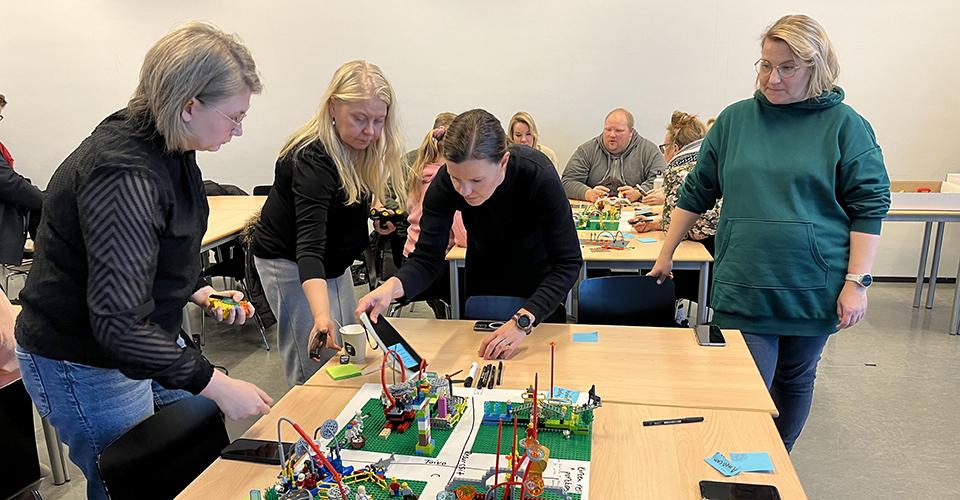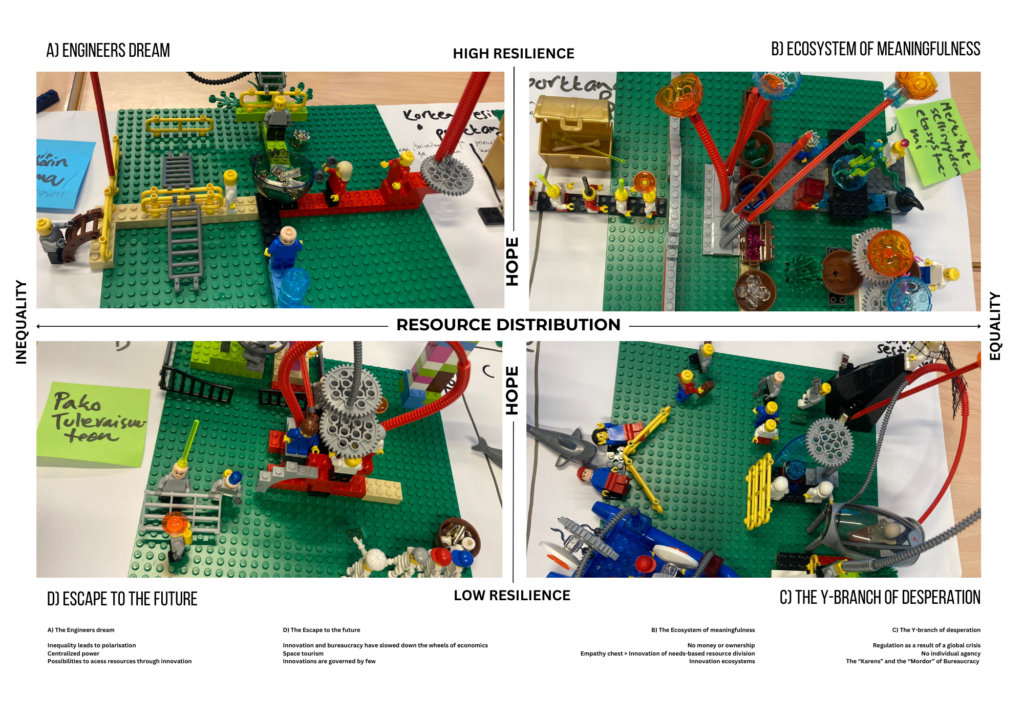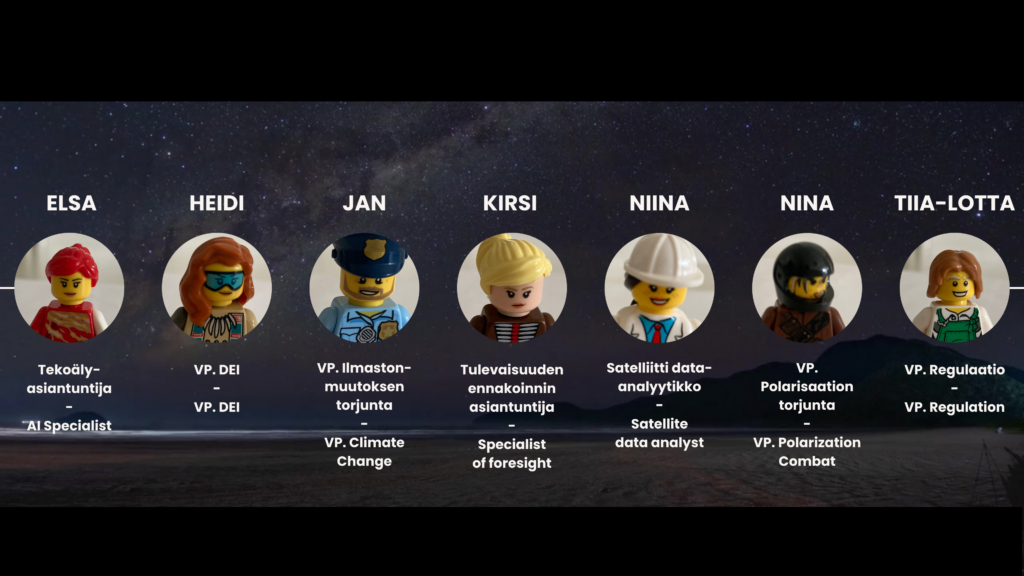
Kirsi Melvola-Georgakarakos, Nina Blomqvist, Tiia-Lotta Lehterä, Jan Lind, Elsa Melkko, Heidi Puttonen, Niina Saranen & Minna Pura
Breaking the habit of how things have been done in the past require techniques that foster creativity and imagination. Transformative scenario work is a collaborative process, where the scenarios are constructed in interaction with others. Interactive, transformative futures research techniques help us design sustainable futures together.
Introduction
In pedagogic terms, recent literature talks about transformative learning and teaching (Arbeiter & Buéar 2021; Balsinger et al. 2017; Mezirow 2000) and eco-social sustainability education that encourages global thinking and taking an activist stance in the green transition, exploring interlinked phenomena in nature, economy, and society from multiple perspectives. All in all, there is a need to examine the transformative process (Sterling 2010) and reflect our relationship with the reality that surrounds us (Arbeiter & Buéar 2021) to solve wicked challenges that require a collaborative effort.
One concrete method how education can facilitate sustainability is scenario work that envisions different futures and consequences of today’s actions. Transformative scenario work is a collaborative process, where the scenarios are constructed in interaction with stakeholders, as strategic situations are always socially constructed. Such interactive, transformative futures research techniques help us design sustainable futures together.
Techniques also foster creativity and imagination – important futures skills – breaking the habit of how things have been done in the past. Critical thinking and communication skills are also important in driving change. In this experiment, we applied LEGO® SERIOUS PLAY® futures workshop methodology as a facilitation technique to foster imagination and construct tangible stories as well as simulate consequences of actions.
As depicted in the figure 1, the students of the course futures leadership and futures research methods participated in a workshop series where two certified LEGO® SERIOUS PLAY® facilitators, Minna Pura and Emilia Risu guided them in the process applying a series of exercises utilizing also other futures research techniques, all with a playful mindset aligned with the LEGO® SERIOUS PLAY® way of inclusive and collaborative working, tapping also to the unconscious mind and collective intelligence for building possibilities out of challenges.
The workshop series concluded with insights for further career development and innovations, guiding participants to identify possibilities and challenges in each of the scenarios. This article was initiated by the enthusiastic student group who now is on a mission, presenting their learning journey as the team “Guardians of the Earth”.
The space ecosystem is already all around us and touches many aspects of daily life, as technological progress is unlocking new capabilities, encouraging more commercial funding in space, and making space more accessible. The process and some examples of the results produced by the students during the course are presented next.
We started the journey from the year 2050. In this paper we present some implications back casting to the year 2034, what skills, capabilities and meta skills vocational education should aim to develop in the next 10 years, to foster development of professionals who can guide us in the next industrial revolution and make the best out of the futures images depicted in our scenarios.
Scenarios
The collaboratively identified change drivers were space technology development as well as natural resources and biodiversity loss (Crider et al. 2023; Black, Slapakova, & Martin 2022; Iacomino 2018). However, while the finite nature is known, climate crisis is a visible and long-term global megatrend leading easily to dooms-day scenarios, technological innovations and resilience mitigated these risks.
The workshop resulted in scenarios where hope (resilience) and resource distribution (resources), the collaboratively prioritized critical driving forces, acted as horizontal and vertical axis (Figure 2). On these axis two scenarios were built to describe high resilience and two low resilience perspectives. The high resilience views emphasize global hope with fast paced innovation and reward motivated actions. The low resilience views emphasize regulation, slow innovation, and development, with enforced actions through regulation. All scenarios were named in a descriptive manner.

The four scenarios built iteratively were:
A) Engineers dream – raises engineers to power with critical innovations (centralized resources, high resilience)
This scenario envisions a world led by engineers who leverage critical innovations to manage Earths’ resources. As the key knowhow is largely within mathematical and natural sciences, engineers lead fast paced innovation leading to many critical global problems being solved through high-technology solutions resulting in smarter use of natural resources (Crider et. al., 2023). Global citizens must negotiate their access to resources with engineers, and this often requires highly evolved negotiation skills and strategic intelligence. While these foster problem-solving, it centralizes power and creates societal inequalities, potentially leading to conflict. Conflicts and wars stemming from need for resources and power are a constant threat.
B) Ecosystem of meaningfulness – empathy wins (decentralized resources, high resilience)
In this scenario empathy becomes the cornerstone of the post-modern empathy-based society through a high-technology innovation, enabling equal, needs based resource distribution, leading to fostering collaboration. Innovation and collaboration thrive in ecosystems of innovation. Resources are shared needs based, but potential external and extraterrestrial threats might be neglected. There is no centralization of wealth nor power, as money and ownership have lost their meaning.
C) The Y-branch of desperation – segregates (decentralized resources, low resilience)
A major global crisis necessitates segregation of population and stringent regulations in this scenario. A part of the population has been left to Earth, and another part has been taken to space to secure new resources (Crider et. al. 2023; Black, Slapakova & Martin 2022). Resources are meticulously distributed, but extreme bureaucracy stifles innovation, creating a stagnant, though equal, society. Society monitors its members through all-encompassing AI and decides on individual destinies. The individual is given the role of servant to the faceless society. The lack of individual agency could lead to societal regression.
D) Escape to the future – increases polarisation (centralized resources, low resilience)
This scenario focuses on future where technological advancements solve most of Earth’s wicked problems, but resources and innovation become monopolized by a global, centralized authority. This leads to the slowing down of global economy and innovations fuelling societal polarization and conflict. Space tourism thrives as individuals want to leave the Earth to the peace of the space (Crider et. al. 2023; Black, Slapakova & Martin 2022). The wealthy escape to newly developed space habitats, neglecting Earth’s remaining problems and exacerbating a “brain drain.”
Implications
Since scenarios assist us to conceptualize the unpredictable, the unforeseen, they are one of the most used methods within strategic future planning tools. The strategic futurist Schwarz (2023) sees scenarios as alternative futures images that can be used either to support decision-making or to challenge our existing thought models. However, if scenarios were built primarily based on measurements of past actions, it is difficult to envision radically different futures whilst remaining in the realms of future possibilities (Koskelo 2021).
Through the application of constructive and transformative methods it is possible to encourage imagination and creativity in an engaging and enjoyable manner (Kahane 2012). The methodology further helped in storytelling, depicting collective resonance situations and possible changes in sociocultural environments (Schwarz 2023). The three-day iterative process resulted in an idea of a technological innovation using new space and development stage space technologies that could help to protect the Earths’ biodiversity in the future.

The scenario work also assisted the students to identify future skills development areas and career possibilities, driving both individual and societal change (Dufva, Solovjew-Wartiovaara & Vataja 2021). The imagination was fuelled with imagined professional identities, personas that reflected the past backwards from the year 2050, depicted in the Figure 3.
Discussion
The construction and exploration of future images in a vivid, visual, and descriptive transformative scenario work was simultaneously challenging and highly rewarding to the participants. Since the constructed LEGO® models worked as metaphors to the working group views and thoughts, it assisted in creating deep, common understanding of complex concepts. Through iterations, the storytelling became effortless and imaginative solutions were built in continuous group interaction, where one view fed the views of others. The created shared understanding created a cycle of positive change and aided in innovation within a tight timeline.
Authors
Kirsi Melvola-Georgakarakos, MBA student, kirsi.melvola(at)gmail.com.
Nina Blomqvist, MBA student, nina.blomqvist(at)outlook.com.
Tiia-Lotta Lehterä, MBA student, tiialotta.lehtera(at)gmail.com.
Jan Lind, MBA student, jan.lind(at)student.laurea.fi.
Elsa Melkko, MBA student, elsa.melkko(at)gmail.com.
Heidi Puttonen, MBA student, heidi.m.puttonen(at)gmail.com.
Niina Saranen, MBA student, niina.saranen(at)gmail.com.
Minna Pura, PhD, senior lecturer, minna.pura(at)laurea.fi.
All from LAUREA University of Applied Sciences.
References
Ahvenharju, S., Lalot, F., Minkkinen, M. & Quiamzade, A. 2021. Individual futures consciousness:
Psychology behind the five-dimensional Futures Consciousness scale. Futures, Vol 128, 2021.
https://doi.org/10.1016/j.futures.2021.102708.
Arbeiter, J. & Buéar, M. 2021. Transformatiivinen koulutus, koulutus muutoksen välineenä, oppaat ja käsikirjat 2021:6. Opetushallitus.
Balsinger, J., Föster, R., Mader, C., Nagel, U. & Zimmermann, A. B. 2017. Transformative Learning and Education for Sustainable Development. GAIA 26 (4), 357–359.
Black, J., Slapakova, L. & Martin, K. 2022. Future Uses of Space Out to 2050: Emerging threats and opportunities for the UK National Space Strategy. Santa Monica, CA: RAND Corporation. Referred 25.11.2023. https://www.rand.org/pubs/research_reports/RRA609-1.html.
Crider, K., Martin, M., Baker, A., Bruegger, J., Burke, C. & Ravichadran, A. 2023. Earth 2040: Predictions for the future of spacetech. Deloitte Ventures.
Dufva, M., Solovjew-Wartiovaara, A. & Vataja, K. 2021. Työn tulevaisuudet megatrendien valossa. Referred 25.11.2023. https://www.sitra.fi/artikkelit/tyon-tulevaisuudet-megatrendien-valossa/.
Iacomino, C. 2018. Evolution of Innovation Mechanisms to Support the Post-2030 Agenda Goals: Case Study on the European Space Exploration Programme. In A. Froehlich (Ed.), Post 2030-Agenda and the Role of Space, s. 153–166. Springer Cham. https://doi.org/10.1007/978-3-319-78954-5.
Kahane, A. 2012. Transformative scenario planning: changing the future by exploring alternatives. Strategy & Leadership. Vol. 40 No. 5, pp. 19–23.
Koskelo, M. 2021. Tehtävänä tulevaisuus. Tulevaisuusmuotoilu päätöksenteossa. Helsinki: Alma Talent. 182–200.
Mezirow, J. 2000. Learning as transformation: Critical perspectives on a theory in progress. San Francisco: Jossey-Bass.
Schwarz, J. O. 2023. Strategic Foresight: an introductory guide to practice. 1st Edition. Abingdon, New York, U.S.A: Routledge. 59, 87, 90, 92, 129–130.
Sterling, S. 2010. Transformative Learning and Sustainability: sketching the conceptual ground. Learning and Teaching in Higher Education, 5, 10–11.



